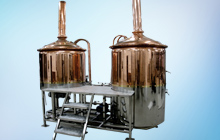BREW HOUSE
Mash Tun & Adjunct cooker
- Mash Tun
- Lauter Tun
- Wort Kettle
- Whrilpool
The mash tun is the simplest device for mashing and preparing sweet wort. Mash conversion and wort separation from the spent grains take place in different vessel, and so mash tuns should be distinguished from the mash mixing and incubation vessels which are used to carry out the mash conversion step only, wort collection being carried out in a separate device, usually a lauter tun or a mash filter. As simple as the mashing process looks in principle, it is as complex as its various functions. When designing a mash vessel, all these functions are of considerable importance and must be taken into consideration.
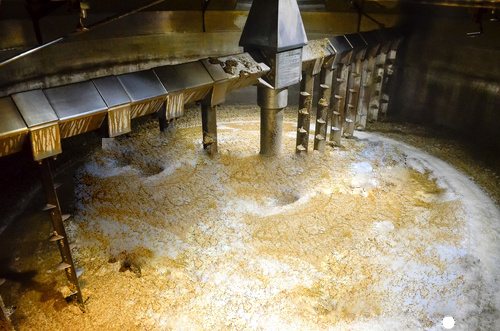
Technical and process functions like temperatures, circumferential speeds, agitator design, vessel wall temperatures, physical and biochemical conversions are all characterizing the mashing process in the brew house. The effectiveness and quality of the mashing process will influence significantly the wort quality and the character of the finished beer.
A sophisticated combination of equipment and technology
As simple as the mashing process looks in principle, it is as complex as its various functions. When designing a mash vessel, all these functions are of considerable importance and must be taken into consideration. To guarantee that all requirements are met, our mash tuns and mash tun kettles have all the necessary technical process features. This starts with an equal temperature distribution over the mash contact area in the vessel, which is ensured by our specially designed vessel heating jackets. Should the brew house plant be equipped with our energy storage system, it is possible - with appropriate excess heat from wort boiling - to supply the mashing process with heat recovered from wort boiling vapors or from a combined heat and power plant. These fuel savings go hand in hand with an important technological advantage: the mash is heated up very gently via the additional, thermically optimized heat transfer areas in the vessel. This keeps the temperature of the interface region on the mash side extremely low.
Adjunct /Rice cooker & Mash Tun consist of pre-masher, multiple steam heating jacket on bottom cone & shell for Independent heating zones, VFD based Agitator at the bottom of the tank that facilitates mixing process with lower shear force and higher heat conductivity, CIP cleaning device, Insulated with the SS weld able cladding. The grist is mixed with water to form a mash which is carefully heated and agitated in the mash tun. Under controlled temperatures the natural enzymes begin converting the insoluble starches and proteins into a soluble malt extract known as the wort, which contains fermentable sugars including maltose.
Is a vessel for separating the wort from the solids of the mash. lautring is nothing but filtering . A lauter tun works much like a large sieve. It normally has a slotted, perforated floor, also called a false bottom, which holds the spent milled grains, while allowing the wort to filter through the grain bed and collect in the space beneath; the wort then runs to the brew kettle. The performance of a lauter tun depends on many factors. The number of brews per day is not the only decisive criterion. Brew cycle, raw materials, milling method, cutting technique, wort concentration and weak wort management – all these aspects play an important role in the lautering process.
For many decades, ABW Prodeb has been at the forefront of optimum performance of the lauter tun. In the LAUTERPRO™, our engineers and brewing experts have applied their know-how and expertise to advance the technology of many major components, from the geometrically optimized wort run-off system up to the highly efficient raking machine. The result is a lauter tun that sets standards in terms of functionality and performance. The
The LAUTERPRO™ can handle any cycle and, with up to 11014 brews per day, it sets the pace in the brewing process.Thorough extraction, higher yield. A characteristic feature of the ABW PRODEB raking machine apart from its competition is the denser arrangement of knives. This arrangement, with the double shoe, leads to a very intensive, even and gentle treatment of the grain bed. The geometrically optimized wort run-off system increases plant efficiency in various respects: better and faster extract recovery with even spent grains leaching across the entire lauter tun. In short: The LAUTERPRO™ utilizes your resources to the optimum and maintains consistently high wort quality.
A characteristic feature of the ABW PRODEB raking machine apart from its competition is the denser arrangement of knives. This arrangement, with the double shoe, leads to a very intensive, even and gentle treatment of the grain bed. The geometrically optimized wort run-off system increases plant efficiency in various respects: better and faster extract recovery with even spent grains leaching across the entire lauter tun. In short: The LAUTERPRO™ utilizes your resources to the optimum and maintains consistently high wort quality.
Concentrated intelligence for the lautering process
The LAUTERPRO™ is a top performance lauter tun which, with the addition of our intelligent lautering program Multifunctional Lautering Management (MLM), becomes even better. MLM optimizes all phases of the lautering process – lautering time, yield, wort quality - depending on relevant parameters. Today, MLM is successfully applied in many plants all over the world and can be integrated into existing systems.
Concentrated intelligence for the lautering process
Whether raking machine, wort run-off or false bottom – it is possible to retrofit individual components of the LAUTERPRO™ technology. And an upgrade of your existing lauter tun will already result in a considerable increase in capacity, as comparative analyzes of specific applications show. The upgrade could pay-back within only 4 TO 6 months.
THE term Lauter comes from the German word abläutern, meaning roughly “to rinse off” or purify. Lautering is a process in brewing beer, in which the mash is separated into the clear liquid wort and the residual grain. Lautering usually consists of 3 steps: mashout, recirculation, and sparging.
Only the wort is used for beer production. This separation process is called lautering or filtration depending on with what the mash separation is performed: either with a Lauter tun or a Mash filter. In a mash filter, the filtration occurs primarly through close-meshed filter cloths fixed on plates. This enables better recovery of the extract absorbed in the spent grains. Furthermore, through a large amount of filtration plates, a larger filtration’s area is created, which means as well a faster process.
At prodeb we understand state-of-the-art wort boiling as an interrelated package comprised of the heating-up process, the actual wort boiling and the wort treatment during cast-out. Only the holistic approach achieves best values in terms of beer quality and in energy efficiency
Once the wort is separated from the husks, it is transferred to the wort kettle to be boiled. This process develops colour and flavour. Boiling helps extract the bitter and aroma substances from the hops, which are introduced at this stage together with the sugar. The boiling also sterilises the wort and inactivates the malt enzymes, prior to the introduction of the yeast in the next stage.
The superpro™ provides a completely innovative process in atmospheric kettles: two-phase boiling. This method, with two separate steps, gently and efficiently boils the wort using an internal boiler in natural circulation. In the first phase, the conversion process, the innovative subjet system provides a more homogeneous circulation with minimum thermal stress. In the second phase, the two-level wort spreader ensures intensive evaporation. Intermediate cleaning during wort boiling is not required. superpro™ can be supplied as part of a new installation or easily retrofitted to existing plants.
Dynamic process, optimum stripping
The super pro™ allows a completely innovative process in atmospheric kettles: the two-phase boiling. This method with two separate steps makes wort boiling with an internal boiler using natural circulation much more gentle and energy-efficient. In the first phase, the conversion process, the subjet system provides for a more homogeneous circulation with minimum thermal stress. In the second phase, the two-level wort spreader ensures very intensive evaporation and stripping of volatiles. Intermediate cleaning during a brewing week can be reduced to a minimum.
Whether raking machine, wort run-off or false bottom – it is possible to retrofit individual components of the LAUTERPRO™ technology. And an upgrade of your existing lauter tun will already result in a considerable increase in capacity, as comparative analyzes of specific applications show. The upgrade could pay-back within only 4 TO 6 months.
THE term Lauter comes from the German word abläutern, meaning roughly “to rinse off” or purify. Lautering is a process in brewing beer, in which the mash is separated into the clear liquid wort and the residual grain. Lautering usually consists of 3 steps: mashout, recirculation, and sparging.
Only the wort is used for beer production. This separation process is called lautering or filtration depending on with what the mash separation is performed: either with a Lauter tun or a Mash filter. In a mash filter, the filtration occurs primarly through close-meshed filter cloths fixed on plates. This enables better recovery of the extract absorbed in the spent grains. Furthermore, through a large amount of filtration plates, a larger filtration’s area is created, which means as well a faster process.
The best thing is: The super pro™ can be retrofitted to existing plants without much effort.Your benefits at a glance:
- More flexible wort boiling technology with two-phase boiling: Thermal conversion processes and evaporation are independent from each other
- Homogeneous wort mixing in the wort kettle
- Technological flexibility
- Economical and technological advantages
- Energy savings due to low evaporation
Internal reboiler system uses a shell heat exchanger located inside the kettle. Wort is forced through the boiler mechanically. It’s designed to minimized shear force and less heat loss.
External wort boiler system wort is heated through a shell and tube heat exchanger that located outside the kettle.
Hop dosing vessel is pressurized tank with The vessel is provided with wort inlet/outlet, CIP spray ball with CIP inlet, pressure relief valve, anti-vacuum valve, seal and safety switch.
ENERGY RECOVERY PLANT the Heat lost from the wort kettle is recovered and used to pre-heat future batches of wort with a vapor condenser on the exhaust stack.
- Reduces the need for steam
- Faster heat-up in the wort kettle based on heating the lauter wort from 72 °C to 92 °C
- less energy demand, lower operational costs, and faster brew times.
Using a Whirlpool vessel is considered the smartest method of hot trub separation But that's not all. Compared to the centrifuge or filter the Whirlpool is also the most economical way of achieving hot break separation after wort boiling in the last stage of wort preparation.
After boiling, the wort is transferred to the whirlpool, here Wort enters the whirlpool in a tangential entry that creates the whirlpool motion. The whirlpool motion draws the trub out of the wort via centrifugal motion and forms a trub “cone” — a pile in the bottom center of the tank. Before moving on to fermentation, the hot wort is be cooled and prepared for the addition of yeast. Hot wort is transferred out of the whirlpool through a plate heat exchanger. This heat exchanger cools the wort very quickly, to about 10 0C, by running chilled water through pipes parallel to those holding the hot wort, as it is sent to the uni-tank for fermentation.
Conditions to achieve the ideal Whirlpool function
prodeb whirlpools have proven to be reliable in operation and work to the highest standards. A technical understanding of the brewing materials and process, of wort properties, fluid dynamics and the complex way they interact, are essential for the design of a Whirlpool vessel. Apart from the raw materials used in the brew and the up-stream conditions in the brewhouse, the successful function of the Whirlpool is very much dependent on the wort mass flow, the entry velocity into the vessel, the vessel geometry and the resulting flow conditions as well as the arrangement of the wort outlets. It is only when all these criteria are in the correct balance that the formation of a compact trub cone in the centre of the Whirlpool can be guaranteed.
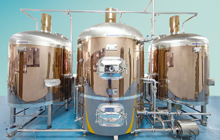
COPPER BREW HOUSE
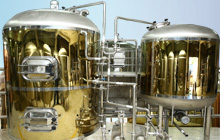
GOLD BREW HOUSE
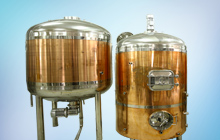
COPPER BREW HOUSE
